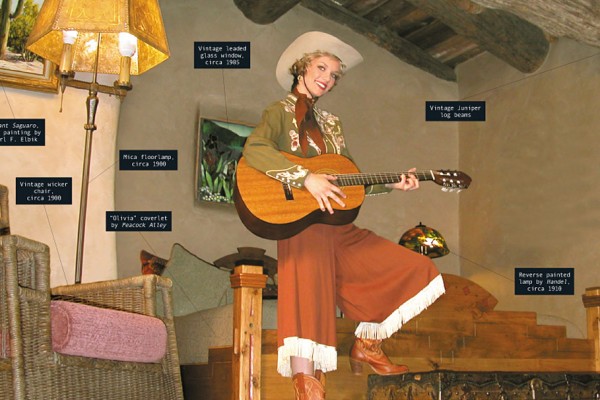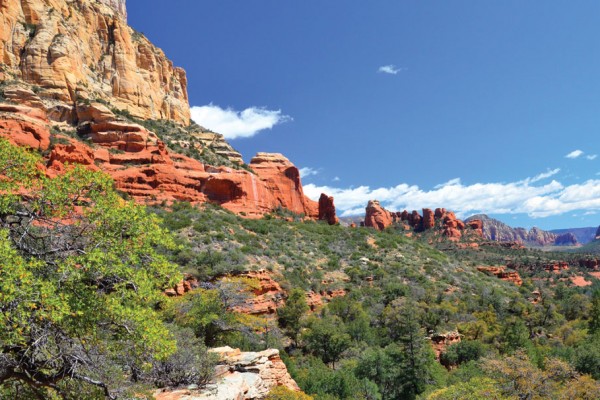Ray turned Chanslor’s story inside out, coaxing from it an ambiguous study of character, emotional repression and mob mentality wrapped in the holsters of a “B”-movie sagebrush saga. The script was labored on well into September 1953, and tinkering with it continued even during filming. At its simplest level, the story is about Vienna (Crawford), a saloon/gambling hall owner despised by the locals, who plans to build her own town once the railroad comes through. Vienna’s lover, an outlaw known as the Dancin’ Kid (Scott Brady), previously had spurned Emma (Mercedes McCambridge), a venomous local cattle rancher. When the Dancin’ Kid tries to rob the local bank before fleeing to California, Emma seizes the opportunity to get her revenge on both Vienna and the Kid. Meanwhile, Vienna’s old flame, Johnny Guitar (Sterling Hayden), returns to protect her from the vengeful townspeople.
Ray assembled a first-class cast in Sedona to bring Johnny Guitar to life: McCambridge, the 1949 Oscar winner as best supporting actress for All The King’s Men, perhaps best known today for providing the voice of the demon in The Exorcist in 1973; Hayden, tagged “The Beautiful Blond Viking God” by Paramount Pictures’ publicity department, who was returning to Sedona for the second of three westerns he would ultimately film here; Ernest Borgnine, who would win the Oscar as best actor for Marty in 1955; character actor John Carradine, who would appear in almost 250 movies over half a century; and Ward Bond, longtime member of legendary western director John Ford’s repertory company.
Republic Pictures, a small studio known for churning out low-cost westerns, serials and action movies, was probably the last place anyone in Hollywood would have expected to find all this high-powered talent. Republic was formed in 1935 when Herbert J. Yates’ Consolidated Film Laboratories merged with Mascot Pictures and Monogram Pictures in an attempt to corner the market for “B” movies. Monogram soon pulled out of the deal, but Republic thrived anyway, quickly establishing itself as king of the low-budget studios.
Headquartered at the old Mack Sennett Keystone lot in Studio City, Calif. (renamed CBS Studio Center in 1963), Republic specialized in the crowd-pleasers it called “Jubilee Pictures,” which were typically shot on a speedy seven-day schedule for an economical $30,000. But Republic also produced the occasional prestige film, which it released as “Premiere Pictures.” Budgeted at $1 million and allowed an entire month to shoot, they were meant to give the studio a touch of class. Some of these “Premiere” productions are now considered classics, including Orson Welles‘ Macbeth (1950) and John Ford’s The Quiet Man (1952). As for Johnny Guitar, it’s been reported that studio chief Yates told Ray his only concern was that Crawford, his high-priced star, the former Queen of MGM, “be happy during filming.”
It was during pre-production that it was decided location shooting would take place in Sedona, most likely because Republic already had a permanent western street set at its disposal here, built in 1946 for John Wayne’s Angel and the Badman. The principals moved into the old Cedar Hotel (now the Cedars Resort on 89A), while the rest of the cast and crew bunked at a converted CCC Camp, rechristened the Sedona Lodge, where the King’s Ransom Inn now sits on Hwy 179.
All looked peachy to outsiders at the beginning, judging from a letter written by local resident Ruth Jordan, unearthed at the Sedona Heritage Museum, which provides one contemporary first-person account of how Joan Crawford handled herself in public during her time here. In Mrs. Jordan’s view, Crawford became “a respected and beloved person in the little settlement of Sedona. For nearly a month she lived among us as neighbor and friend, talking with us, allowing her children to play with our local children — thus fitting herself and family into our community life.
“She came early in October so that she might have a few days vacation before starting work on Johnny Guitar. She did not permit a publicity manager to come, for during those days she only wanted to live a normal life — dress in jeans, go to the stores, do her own shopping, pick up the mail, and be friendly with everyone, as is her natural disposition.”
Mrs. Jordan described a chance meeting between Crawford and a young local birthday girl. ‘Here’s something to start your bank account,’ she said, handing the child a folded $20 bill, ‘but I want to give you something personal, too,’ she added as she took a small vial of green grass perfume from her purse.”
Early in production, unit manager John Grubbs suffered a heart attack and was admitted to Lawrence Memorial Hospital in Cottonwood; Crawford apparently paid the expenses for her own doctor in Hollywood to come to Sedona to check on his condition. But her own blood pressure, and those of most everyone else around her, was soon about to rise.
When filming began, Crawford was the consummate professional; always punctual and cooperative, whether reading dialogue when she wasn’t in a scene or taking her place so the crew could set up lighting. In a scene filmed on a frigid Sedona morning, Vienna and Johnny had to escape a pursuing posse by wading in Oak Creek. Rather than using stand-ins, Crawford and Hayden completely submerged themselves under the freezing water. After calling “cut,” Ray thanked his stars by giving them each a bottle of brandy and sending them back to the hotel to dry off.



